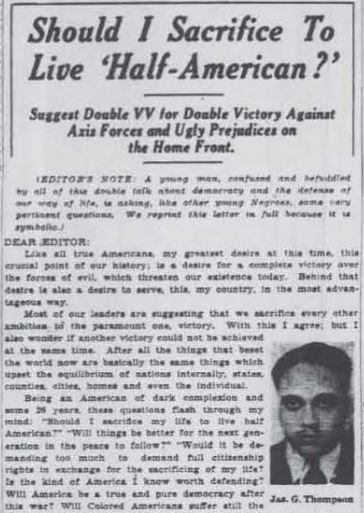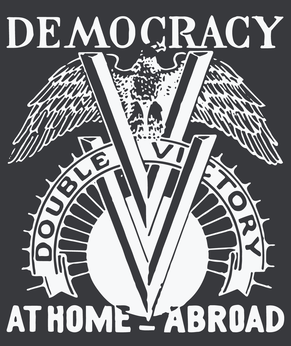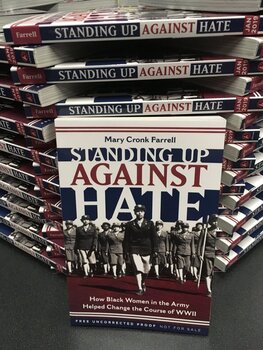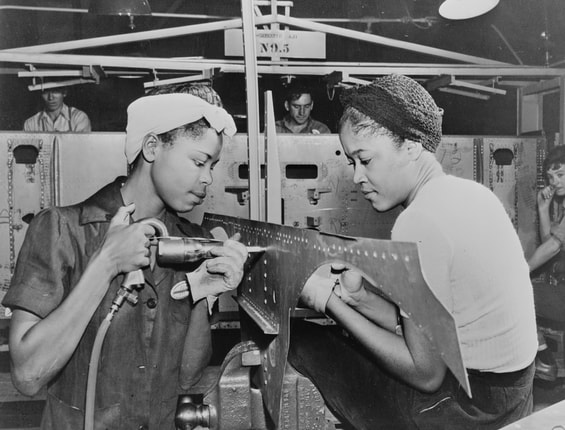|
This past week marked the anniversary of one of the most crucial moments in American civil rights history. February 7, 1942, African Americans launched the Double V Campaign. It started with one man's question. "Should I sacrifice my life to live half American?" And it burgeoned into a force for equal employment opportunity for blacks during World War II, and laid a foundation for the civil rights marches in the 1960s.
 Lieutenant Dovey Johnson Lieutenant Dovey Johnson Not Dovey Johnson, who'd grown up in Charlotte, North Carolina. When she tried to apply for the Women's Army Auxiliary Corps, nobody in Charlotte would give her an application. She moved to Washington DC to get her hands on an application. After completed the segregated training, Dovey became one of the first black women commissioned an US Army Officer. Was it coincidence Lieutenant Dovey Johnson was assigned to recruiting duties in Georgia, and North and South Carolina? Maybe, maybe not. But they sent one very determined woman south of the Mason-Dixon line. Dovey feared the small gains black women had made in becoming officers in the army would be lost, unless more black women volunteered. “That, I determined, would not happen—not on my watch, no matter how tough a sell I had on my hands in pitching a Jim Crow WAAC in the Deep South.” “Was that opportunity precisely, mathematically, documentable equal to that of whites? probably not. But the WAAC offered a chance I believed would never come again in quite the same way: the chance to advance, to train for careers, to build the kind of future we women wanted for our children, to stand behind the men who were fighting in Europe and North Africa and the Pacific. That mattered most of all. Our boys were dying for freedom, I pointed out in every speech I made. What was segregation compared to that?”  Across the country, many blacks did not share Dovey's enthusiasm. Popular V for victory signs had popped up to cheer the fight against race prejudice, aggression and tyranny in Europe and Asia. One black man, James G. Thompson, wrote a letter to a prominent black newspaper, The Pittsburgh Courier. Thompson wrote in part: Being an American of dark complexion and some 26 years, these questions flash through my mind: “Should I sacrifice my life to live half American?” “Will things be better in the next generation for the peace to follow?” “Will Colored Americans suffer still the indignities that have been so heaped upon them in the past?” These and other questions need answering: I want to know and I believe every colored American who is thinking, wants to know. Thompson went on to suggest doubling the V for Victory. The first V for victory over our enemies from without, the second V for victory over our enemies from within. For surely those who perpetuate these ugly prejudices here are seeking to destroy our democratic form of government just as surely as the Axis forces.  The Pittsburgh Courier had swiftly drawn the connection in 1939, between treatment of blacks in the US and Nazi Germany’s treatment of Jews. President Franklin D. Roosevelt asked the Courier to tone down its rhetoric about racial discrimination. And the paper did let up. Until the US joined the war, and huge numbers of blacks were drafted for service. The newspaper asked readers what they thought about this Double V. Hundreds of telegrams and letters inundated the newspaper's office voicing agreement. The Courier established the Double V Campaign as "the true battle cry of colored America....the Double "V" war cry–[signifies] victory over...our enslavers at home and those abroad who would enslave us. WE HAVE A STAKE IN THIS FIGHT....WE ARE AMERICANS TOO!"  Double V handkerchief Double V handkerchief By the summer 200-thousand black people had joined the Double V Campaign, each paying a nickel to the Courier, which continued to promote the slogan, dedicating close to 15% of its newspaper to the subject each week. Newspaper Historian Patrick Washburn describes the fervor. "You had women walking around with Double V's on their dresses. You had a new hairstyle called the Doubler where black women would weave two—;two V's in their hair. You had Double V baseball games, Double V flag waving ceremonies, Double V gardens. I mean it's just Double V this, Double V [that]....There was even a Double V song." But no amount of Double V's guaranteed progress against racism in America and skepticism ran deep. Civil Rights activists A. Philip Randolph and Bayard Rustin knew that now, when the country was in crisis and needed them, it was time to demand equality. They organized a massive March on Washington to pressure President Roosevelt. The president had promised the US would become the “arsenal of democracy." American industry and manufacturing would have to gear up as never before. Randolph and Rustin organized tens of thousands of blacks to march on the capital demanding equal opportunity to the millions of high-paying jobs that would result. Such a display of America's racial injustice would be embarrassing on the world stage. President Roosevelt asked Randolph to call off the demonstration promising an executive order to increase job opportunity for blacks. In June, 1941, Executive Order 8802 banned discrimination in defense industries and government and created the Fair Employment Practices Committee for enforcement. Luedell Mitchell and Lavada Cherry helping build an airplane in the El Segundo Plant of the Douglas Aircraft Company (Library of Congress)
Executive Order 8802 was the first time since Reconstruction that the federal government explicitly protected equal rights for African Americans. Though enforcement was not ideal, civil rights activists now had a tool in their "arsenal for democracy." Despite the Double V campaign, segregation and racial injustice continued after the war. But it helped lay the foundation for 1960's protest marches in the fight for the Civil Rights Act of 1964. If you enjoyed this story, Click and sign up here to get another every week in my author newsletter. Sources The Double V Campaign (1942-1945) (blackpast.org) First Person Oral Histories - Ray Elliot (mass.edu) Executive Order 8802 - Teaching American History http://explorepahistory.com/kora/files/1/2/1-2-F3C-25-ExplorePAHistory-a0k1v1-a_349.jpg Comments are closed.
|
I'm fascinated to discover little-known history, stories of people and events that provide a new perspective on why and how things happened, new voices that haven't been heard, insight into how the past brought us here today, and how it might guide us to a better future.
I also post here about my books and feature other authors and their books on compelling and important historical topics. Occasionally, I share what makes me happy, pictures of my garden, recipes I've made, events I've attended, people I've met. I'm always happy to hear from readers in the blog comments, by email or social media. Archives
September 2023
Categories
All
|


